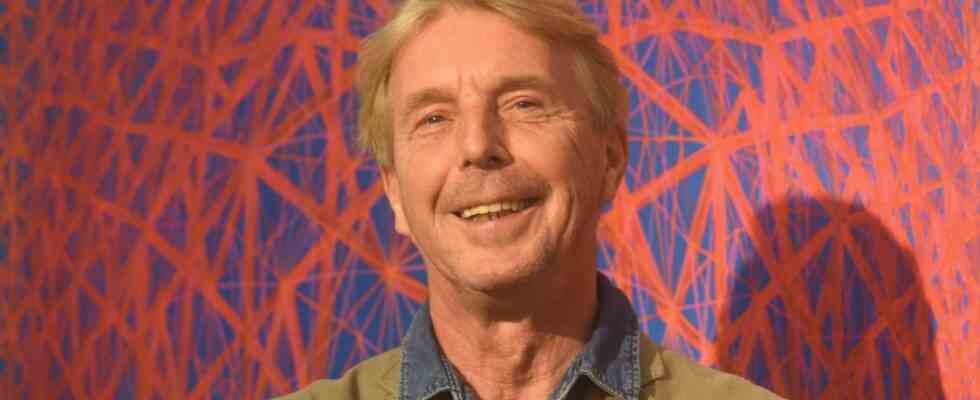Oh yes, the coloring books of yesteryear: you only had to fill in the given areas with numbered colors and the work of art was done. This “painting by numbers” is intended to promote early childhood development. When Ralf Hanrieder talks about his work, he also likes to say that he does “paint by numbers”. Of course, he means something completely different. The Dachau artist has been working with a mathematical concept, the magic square, for decades. It is his trademark and maybe even his unique selling point in art.
The result is unexpectedly sensual and intense. In the vibrating tangle of strokes, funnels open, waves rise, suck whirlpools of amazing spatiality in colors of dizzying luminosity.
“Space Warp” is a spectacle of red and green, the complementary colors collide head-on, shimmering on the retina. This explosion of form and color is so violent that Hanrieder’s other pictures were hung up at a safe distance in the Dachauer Volksbank. Under the title “Lichtspiel – Raum”, he will be presenting his new works there from Friday. Curator Bärbel Schäfer speaks of an “exhibition with a wow effect”.
The line chart is his universal building block
Before you get to the wow, you first have to insert a short Telekolleg: A magic square is a square of numbers whose rows added together horizontally, vertically or diagonally always result in the same sum. With an area of nine squares, it is 15. If you connect the squares from 1 to 9, you get a bar chart, like you can find thousands of times in Hanrieder’s pictures. It is the universal building block of his work, like the note for the musician or the letter for the writer.
The fact that Hanrieder’s exhibition is the 15th in the “Art and Bank” series, like the sum of the digits of the magic square, is a particularly striking point. Coincidence? “There are no coincidences,” says the artist and laughs. But Hanrieder is no number mystic, he simply describes the magic square as a “tool” or “vehicle” for his art.
Cosmic: “Red Medusa” painted on an aluminum plate.
(Photo: Toni Heigl)
Down to earth: picture from the cheerful series “Kettenkarussell”.
(Photo: Toni Heigl)
Fractal landscape: “Yellow Mountains”.
(Photo: Toni Heigl)
The truth behind the “Madonna” is an Afghan refugee girl.
(Photo: Toni Heigl)
It’s a tool that also takes a lot of work. According to the artist, he worked on the largest picture, the 1.90 by 2.50 meter work entitled “Before and behind the mirror”, for eight months. He likes to compare his painting work to meditation or a monk’s mantra. The eternal repetition does not create boredom. She creates depth.
In the large characters, the artist paints smaller ones. Where they condense, fractally multiplied, the images seem to glow from within. Hanrieder speaks of “energetic signatures,” just as he speaks a lot about “energy” and “space,” but never about motifs. The trained lithographer does not see himself as a painter, not as a graphic artist, rather something in between. Concept artist maybe.
The colored structures often condense into very representational motifs in front of the viewer’s eye. The artist skilfully directs and strengthens this mechanism of association. The “Kettenkarussell” series is based on a funnel-shaped structure, which is finished in bright candy colors and exudes the purest folk festival flair. Floral elements can be found in the pictures “Lights over the water”. The oval pictures, which are reminiscent of artistically painted Easter eggs, he wittily explains as “Hommage à Fabergé”. Peter Carl Fabergé became famous for his ornaments in the form of Easter eggs.
Seeing is always also projection
Hanrieder deconstructs viewing habits. The images that you see are often not even on the screen, they are in your head. The title of the exhibition “Lichtspiel – Raum” also refers to this indirectly: Seeing is not only perception, it is always also projection.
This is particularly impressive in the “Madonna” from 2014: At that time, Hanrieder experimented with templates, which he broken down into nothing but small line charts like a roughly rasterized photo. He calls this method “calculated abstraction”.
He chose a photograph by the American journalist Steve McCurry, taken in 1984 in the Afghan refugee camp Nasir Bagh, as his motif. The original image shows a Muslim girl with sad blue eyes and a veil wrapped around her neck and head. And what does the viewer see? The Suffering Mother of God incarnate. An interesting optical illusion. Maybe a deeper truth too. Hanrieder likes to leave things in limbo. You wouldn’t expect anything else from a magician.
During the Long Night of Open Doors on Friday, September 16, the exhibition will be open from 7 p.m. to midnight and will be on display until October 14.

